What is an internal developer platform?
An internal developer platform (IDP) is a collection of workflows and toolchains that encourage development teams to align their technical infrastructure with their organization’s standards. While an IDP can be as simple as documentation on a wiki, it typically involves smoothing the path for a developer’s work to reach production quickly, safely, and securely and ensuring it runs reliably.
Rather than force a single centralized standard for this technical infrastructure, a platform allows developers to choose from an approved set of options, usually presented as golden paths. This strikes a balance between forcing standards on developers, which limits their ability to improve and innovate, and giving them a free choice, which results in a chaotic technical landscape and cost control problems.
This is part of a series of articles on developer experience.
What does an internal developer platform do?
An internal developer platform is a product aimed at the organization’s developers. It provides self-service access to technical infrastructure and workflows such as deployment pipelines or cloud hosting resources. By choosing one of the golden pathways offered by the internal developer platform, developers should have an easier way to build and run their software, increasing the time they can spend on feature development.
This removes ticket wait times for requesting environments and infrastructure compared to traditional operations. It also contrasts with the “you build it, you run it” strategy, where development teams are entirely responsible for their software. This strategy increases the cognitive load on developers, and limits flow time when operations tasks and incidents disrupt feature development.
These platforms also allow specialized enhancements to be applied across all teams using golden paths, such as simplifying cost control for cloud infrastructure, increasing automated security checks within the build process, and providing easy access to monitoring tools.
Core components of an IDP
Internal developer platforms typically include components across 5 categories, development, integration and delivery, monitoring and logging, resources, and security.
Development
The development category includes code editors and version control, which are the tools developers interact with the most. These tool choices are often the focus of developer experience (DevEx) initiatives, though the integration and delivery category is the most impactful investment you can make in DevEx as it accelerates software delivery and crucial feedback loops.
The category also includes any developer portal that surfaces self-service operations developers can consume from the tools and workflows in the internal developer platform. These might include one-click setup for new projects or the ability to self-serve environments and transient environments. Developers may interact with the internal developer platform through a user portal or using APIs or configuration files stored in version control.
Integration and delivery
The integrations and delivery category covers the Continuous Integration and Continuous Delivery (CI/CD) pipeline. While all-in-one tools are on the market, most organizations create a more fully-featured pipeline by using best-in-class tools for builds, test automation, storing artifacts, and automating deployments.
Internal developer platforms can simplify CI/CD pipelines by providing an integrated workflow that meets security, compliance, and change management requirements. Developers can use the pipeline by committing code to version control and spending more time on features rather than configuring their CI/CD pipelines and workflows.
Monitoring and logging
The monitoring and logging category covers the collection, storage, and use of events, logs, and application insights. The platform can make it easier for developers to integrate observability platforms into their applications and services, for example, by providing a library that exposes a simple facade over the selected tools.
The internal developer platform can also apply sensible archiving and retention policies to control the costs of storing large volumes of observability data. Giving developers a self-service way to increase log verbosity temporarily during an incident can keep costs lower during regular operation.
Resources
The resource category includes compute, cluster management, networking, and data. The internal developer platform can provide self-service provisioning and scaling, removing the wait times associated with opening operations tickets. Infrastructure automation removes the manual effort of environment configuration.
Additionally, self-service features allow developers to launch and modify environments on demand, accelerating experimentation and iteration. Standardized templates and automation mean teams can consistently deploy applications, reducing error rates. This allows engineers to focus more on feature development and less on infrastructure issues.
Security
The security category includes secrets management, dedicated security tools, code and container vulnerability scanning, and policy-based controls. These tools can operate in concert with other categories. For example, code scanning is usually included as part of the build process in the CI/CD pipeline.
Including security needs in the internal developer platform reduces developers’ compliance burden and makes software more secure. Opportunities to increase security and improve practices can be amplified as the platform applies them consistently across all development teams using golden paths.
Benefits of an internal developer platform
An internal developer platform that focuses on solving the needs of developers will improve software delivery performance, reduce burnout, and bring standardization benefits to the organization.
Key benefits include:
- Accelerated development cycles: IDPs reduce developers’ time setting up and managing infrastructure by providing pre-configured environments and automation. Developers can quickly access resources and focus on building and delivering features, leading to faster iteration and deployment.
- Improved collaboration: IDPs centralize tools and processes to create a unified workspace for development teams. This reduces friction between developers and operations teams, fostering better collaboration and smoother workflows.
- Enhanced productivity: Self-service capabilities and standardized processes empower developers to manage environments and deployments independently. This reduces the reliance on operations teams and minimizes bottlenecks, significantly boosting productivity.
- Consistency and reliability: Standardized templates and automated workflows ensure consistency across environments and deployments. This minimizes errors, reduces configuration drift, and improves the reliability of applications in production.
- Cost optimization: Transparency into resource usage provided by IDPs allows teams to monitor and optimize infrastructure costs. Developers can avoid over-provisioning resources and align usage with project needs, ensuring efficient budget use.
- Improved application quality: Integrated testing, monitoring, and validation tools within an IDP help maintain high code quality. Teams can catch and resolve issues early in the development lifecycle, leading to more stable and performant applications.
- Scalability and flexibility: IDPs simplify scaling applications and environments as organizational needs evolve. Whether scaling up during peak usage or replicating environments for new projects, IDPs streamline the process without adding operational complexity.
Notable internal developer platforms
1. Qovery
Qovery is a DevOps automation platform that simplifies infrastructure provisioning and application deployment for development teams. It eliminates the need for manual DevOps tasks by automating processes and providing developers with a self-service environment. This helps teams focus on development while ensuring infrastructure remains secure and compliant.
Key features include:
- Cloud infrastructure provisioning: Automates the creation of ready-to-use environments for application development, QA testing, and IT operations. This eliminates redundant manual tasks, enabling faster setup and delivery cycles.
- Self-service tools: Provides developers with self-service capabilities, allowing them to manage environments independently. This reduces dependency on DevOps teams and accelerates project timelines.
- Integrations: Supports integration with existing tools and workflows, including monitoring systems, CI/CD pipelines, and security solutions. Developers can continue using their preferred tools without additional setup effort.
- Governance and custom policies: Ensures compliance and security with custom policies tailored to organizational needs. This allows teams to manage infrastructure while adhering to industry standards.
- Interfaces for accessibility: Offers multiple interfaces such as CLI, API, Terraform provider, and Web UI. These interfaces provide flexibility for developers and teams to interact with the platform using their preferred methods.
![]()
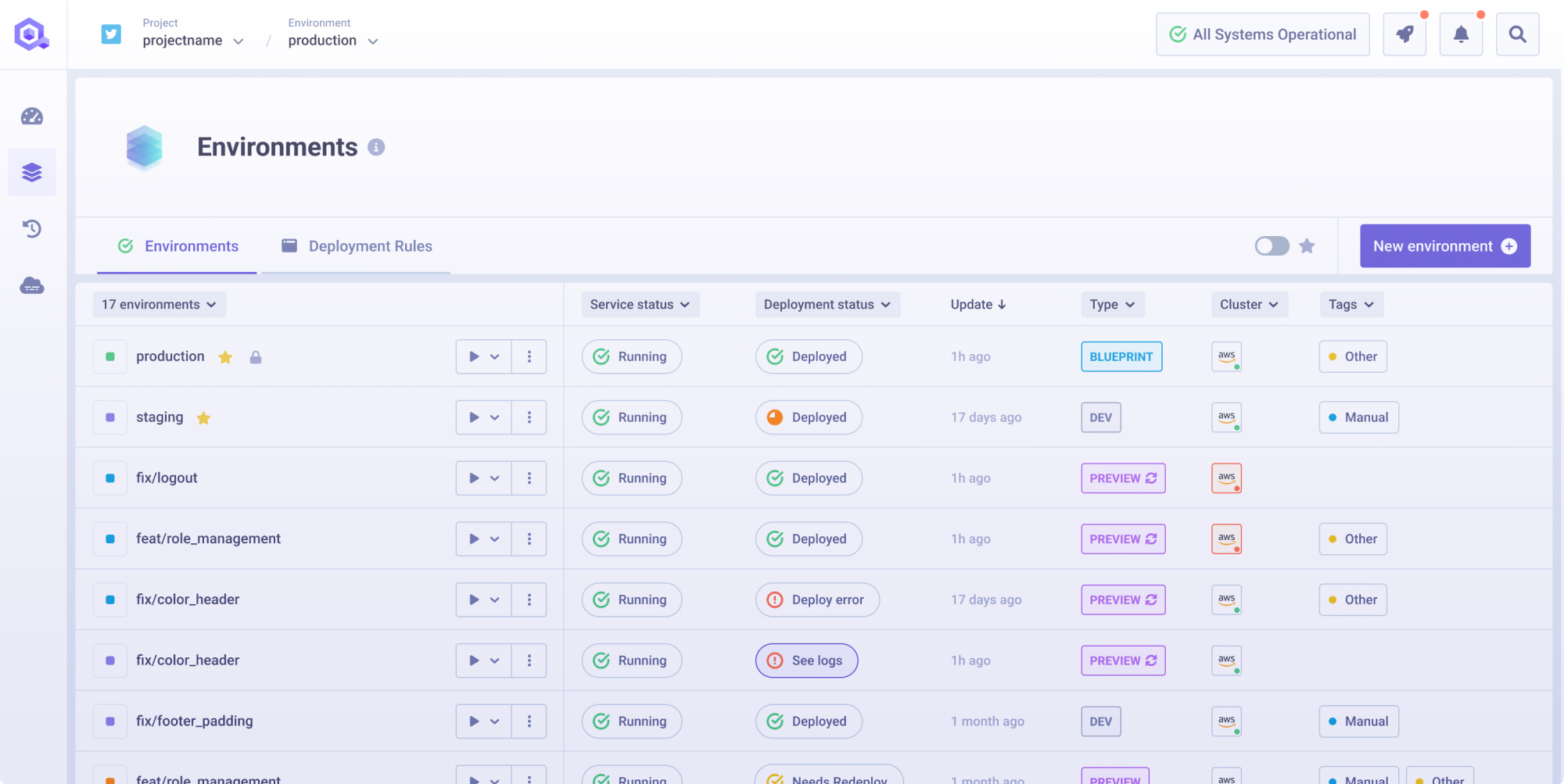
Source: Qovery
2. OpsLevel
OpsLevel is an internal developer portal that provides a platform for cataloging, measuring, and improving software service ownership and quality. By automating catalog creation and enforcing standards, OpsLevel enables organizations to gain visibility into their software ecosystem, improve developer autonomy, and simplify workflows.
Key features include:
- Automated service catalog: Automatically populates a detailed catalog by connecting to sources like GitHub, AWS, and Kubernetes. This includes metadata such as owners, descriptions, tech documentation, and APIs, making it easy to understand the organization’s software landscape.
- Enhanced visibility: Offers a single pane of glass for tracking all services, what they do, and who owns them. Teams can surface critical technical details, reduce manual effort, and improve service discoverability.
- Service ownership and standards: Enables the creation of automated scorecards and health checks to define and enforce service standards. These tools help teams ensure compliance with best practices and identify areas for improvement across their software.
- Integrations: Integrates with a range of tools, including CI/CD platforms, monitoring systems, and incident management tools like Slack, Datadog, PagerDuty, and Jira.
- Developer autonomy: Supports developers with self-service capabilities, reducing dependencies on platform and operations teams. Teams can access actionable data and workflows through a centralized, customizable dashboard.
![]()
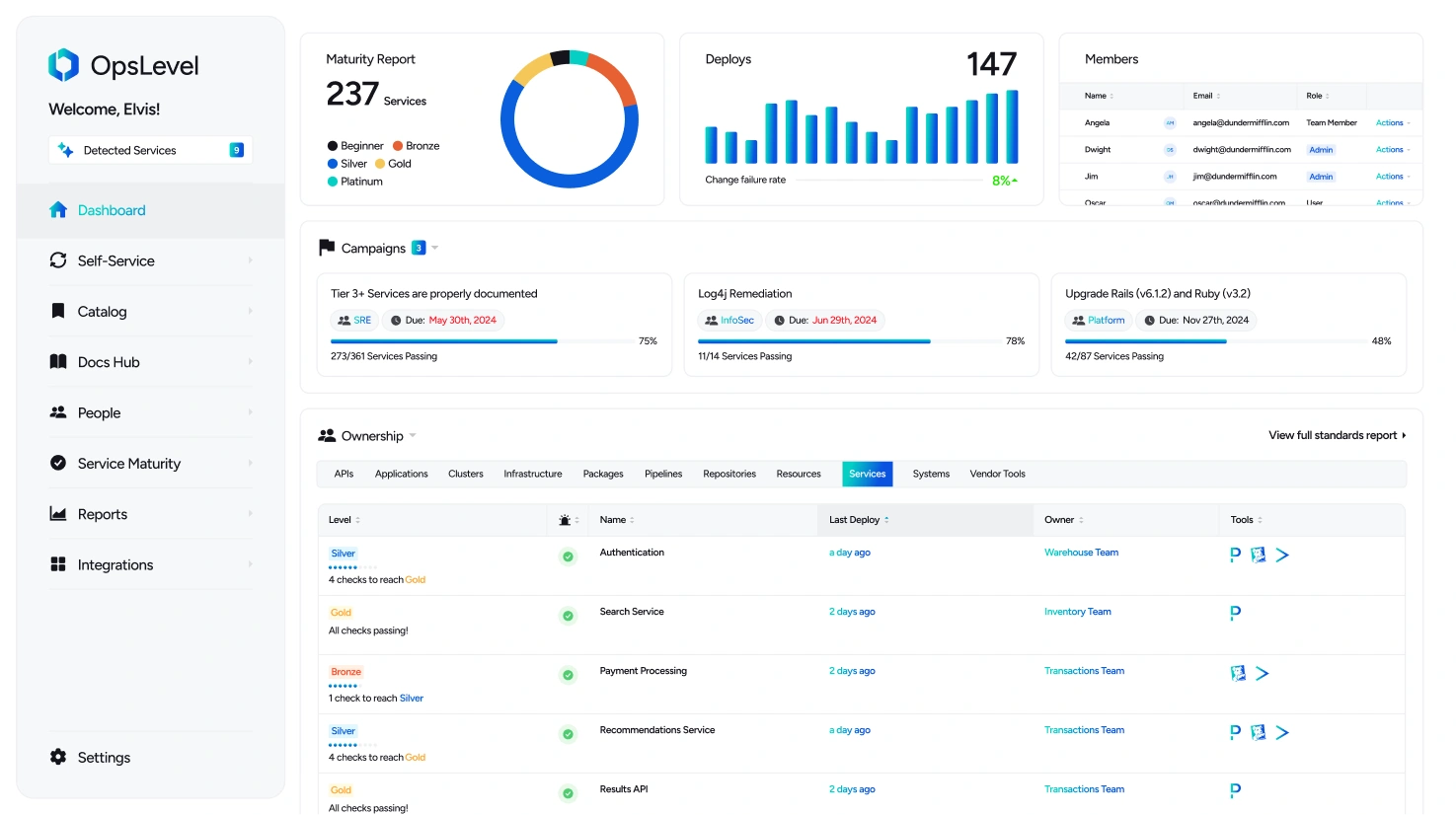
Source: OpsLevel
3. Humanitec
Humanitec is a Platform Engineering solution that simplifies the process of building enterprise-grade IDPs. It provides abstraction, standardization, and visualization tools, enabling organizations to accelerate development cycles, reduce operational overhead, and improve developer satisfaction.
Key features include:
- Platform orchestrator: Centralizes and standardizes workflows for managing infrastructure and application configurations. This ensures consistency across environments while reducing the need for custom scripts and manual configurations.
- Score (workload specification): Offers an open-source workload specification for abstracting complex configurations. This simplifies managing infrastructure across multi-cloud setups, making development processes more predictable and efficient.
- Developer portal: Provides a user-friendly interface that visualizes the platform’s resources, workflows, and configurations. Developers gain insight into their environments, improving accessibility and self-service capabilities.
- Multi-cloud support: Enables integration with AWS, GCP, Azure, and other cloud providers, supporting diverse infrastructure needs while maintaining portability and flexibility.
- Developer self-service: Allows teams to deploy, scale, and manage workloads independently, reducing the burden on operations teams and speeding up the development lifecycle.
![]()
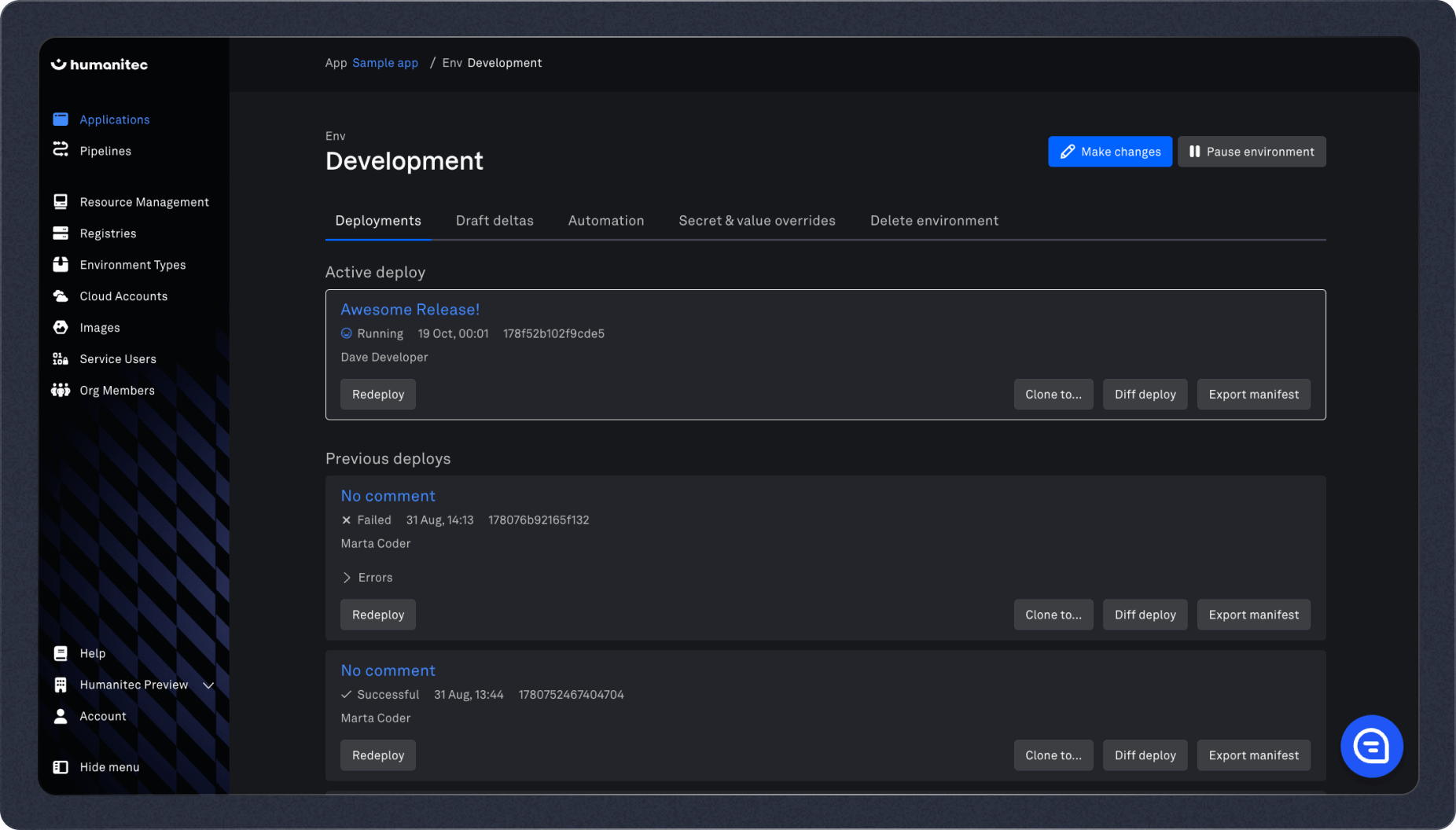
Source: Humanitec
4. Portainer
Portainer is a container management platform that simplifies the deployment, management, and security of containerized applications. Supporting Docker, Kubernetes, and hybrid infrastructures, Portainer provides an interface that reduces complexity, helping developers and IT teams leverage the full potential of container technologies.
Key features include:
- Simplified container deployment: Simplifies the process of deploying containerized applications, reducing operational overhead and allowing teams to focus on innovation.
- Platform management: Offers tools to manage containers at scale across diverse environments, including cloud, hybrid, on-premises, and data center infrastructures.
- Developer self-service: Empowers developers to deploy and manage their environments independently, fostering agility and reducing reliance on IT operations teams.
- Centralized troubleshooting and remediation: Provides an interface for monitoring and resolving issues, accelerating container adoption by minimizing downtime and operational challenges.
- Security and compliance: Implements centralized policies for secure deployment of containers and applications, ensuring compliance without added complexity.
![]()
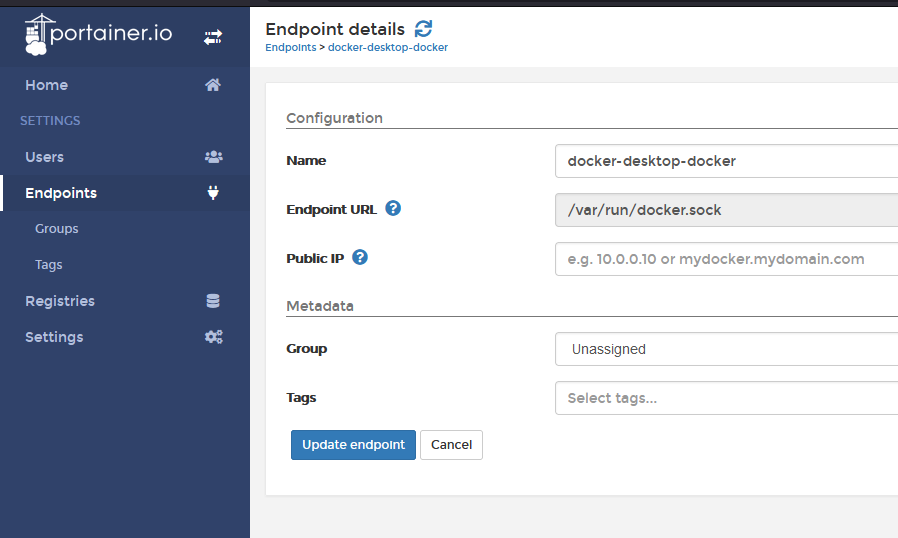
Source: Portainer
5. Coherence
Coherence is a Platform-as-a-Service (PaaS) that empowers teams with control and flexibility in managing cloud infrastructure and deploying applications. Built on CNC, an open-source Platform Engineering framework, Coherence combines the power of Infrastructure-as-Code (IaC) with developer workflows, enabling organizations to create customizable IDPs.
Key features include:
- Developer portal: Offers a UI and CLI for managing environments, monitoring services, and deploying code. Developers can easily access self-service tools for environment management, secrets handling, and observability.
- Infrastructure-as-code execution: Automates provisioning tasks across environments with built-in RBAC, auditability, and configuration capabilities. Platform teams can customize Terraform scripts or write their own infrastructure definitions to meet unique requirements.
- Automated CI/CD pipelines: Integrates with source control providers like GitHub to enable Continuous Deployment. Coherence supports automated builds and deployments from branches, preview environments, and manual promotions via UI or API.
- Environment management: Simplifies creating and managing environments, including production, staging, dev, and ephemeral setups. Teams can provision environments through the portal, CLI, or integrations, with robust GitHub support for preview environments.
- Multi-cloud support: Allows deployment across multiple cloud accounts, with native support for AWS ECS, AWS Lambda, GCP Cloud Run, GCP GKE, and more. Teams can maintain account-level segregation for better security and organization.
![]()
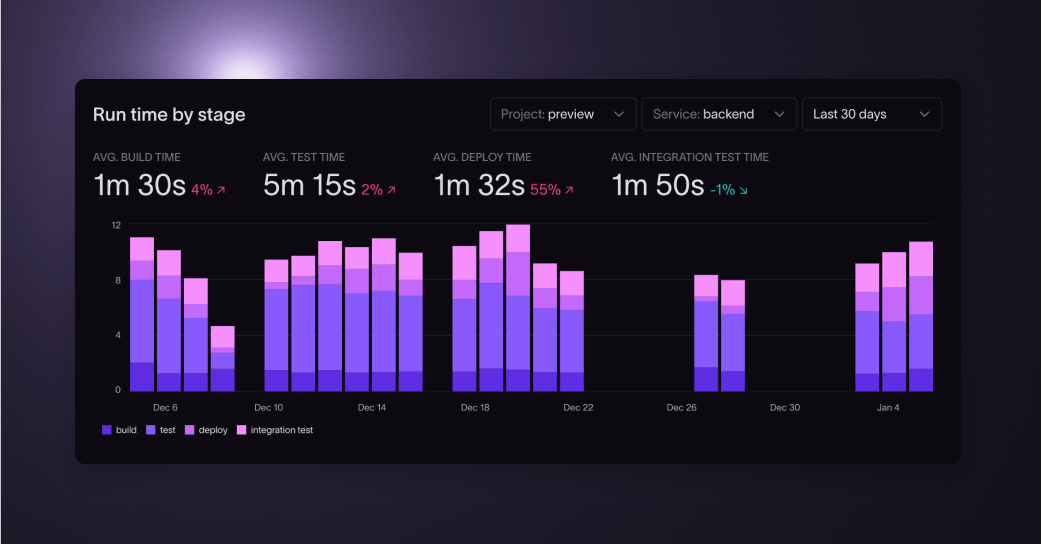
Source: Coherence
6. Mia Platform
Mia-Platform is a platform builder for cloud-native application development at scale. It provides organizations with the tools to build customizable internal developer platforms, enabling self-service capabilities for developers, improving governance for IT leaders, and accelerating application delivery with cloud-native workflows.
Key features include:
- Built-in CI/CD pipelines: Simplifies software delivery with pre-configured CI/CD workflows. Automates build, test, and deployment processes, enabling teams to focus on delivering value rather than managing pipelines.
- Microservices development: Enables design, implementation, and deployment of microservice architectures. Provides tools to manage and scale microservices effectively while reducing complexity.
- API management: Offers tools for managing APIs, including versioning, security, and monitoring. Simplifies integration and promotes consistent API governance across teams.
- Developer experience tools: Assists developers with an interface and self-service capabilities. Teams can manage their preferred tech stack, access environments, and simplify development without dealing with cloud-native intricacies.
- Kubernetes compatibility: Fully supports Kubernetes providers, allowing teams to deploy, scale, and manage applications in any Kubernetes-based environment.
![]()
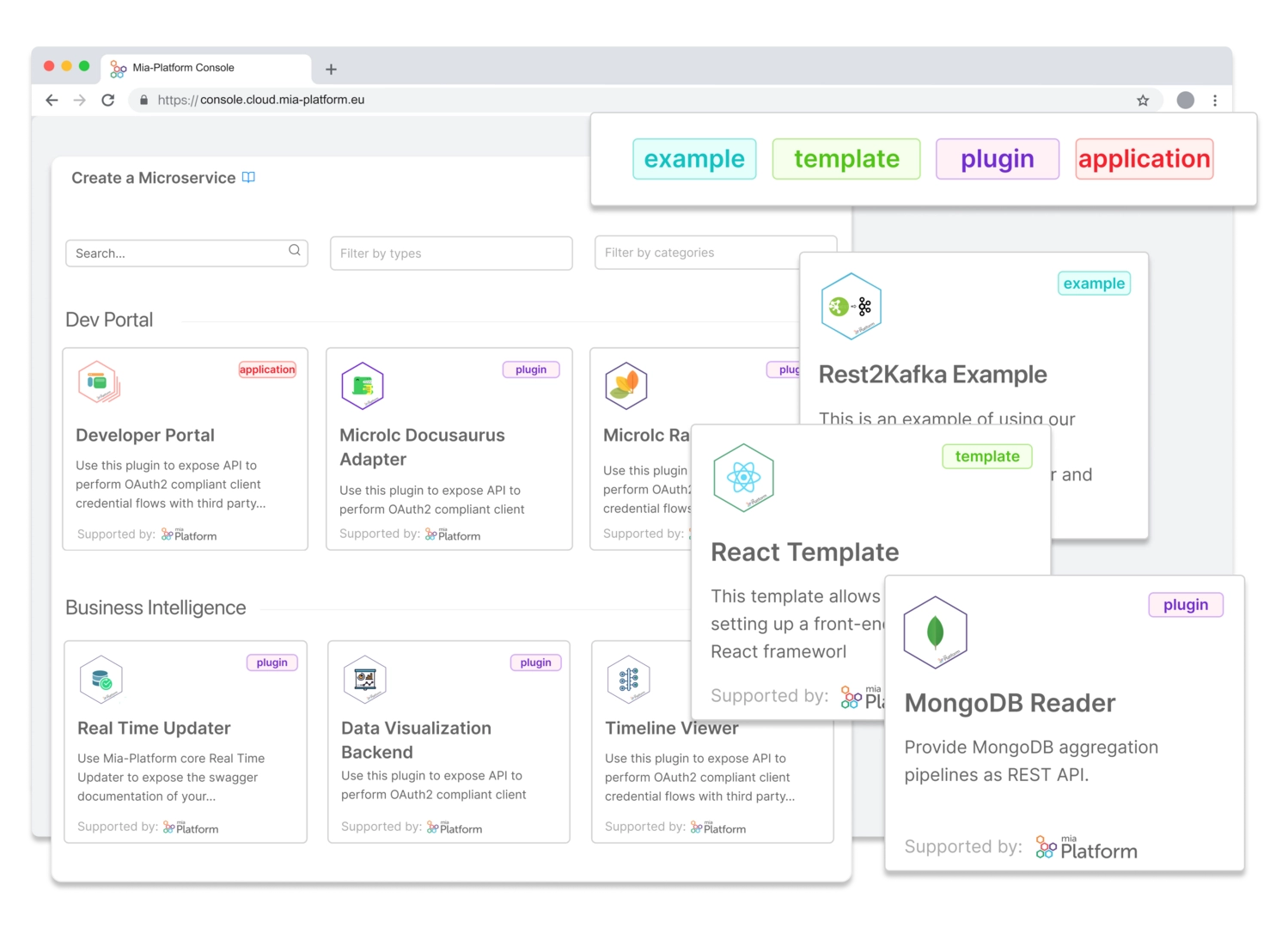
Source: Mia Platform
7. Appvia Wayfinder
Appvia Wayfinder is a developer self-service platform that simplifies cloud infrastructure management while enforcing security and best practices. Designed to integrate with existing technologies, it enables organizations to build scalable, consistent, and standardized platforms across multiple cloud providers, reducing complexity and improving developer productivity.
Key features include:
- Self-service cloud resources: Provides developers with the ability to manage environments, workloads, and dependencies independently, using integrated Terraform modules. Enforces automated security scans to ensure compliance with industry standards.
- Policy-driven developer freedom: Enables teams to work autonomously while adhering to security and cost constraints. Built-in or custom policies, prevent unreliable production environments and minimize risks.
- Environment and infrastructure management: Supports the creation and management of short-lived and long-lived environments. Ensures data protection and infrastructure isolation in line with cloud best practices and well-architected frameworks.
- Consistent and repeatable workflows: Standardizes operations across multiple clouds, providing developers with a uniform experience for application delivery. This reduces technical sprawl and simplifies the developer journey.
- Integration with existing tools: Offers an ecosystem to integrate with current tools and technologies without requiring complex custom engineering, preserving existing workflows while improving functionality.
![]()
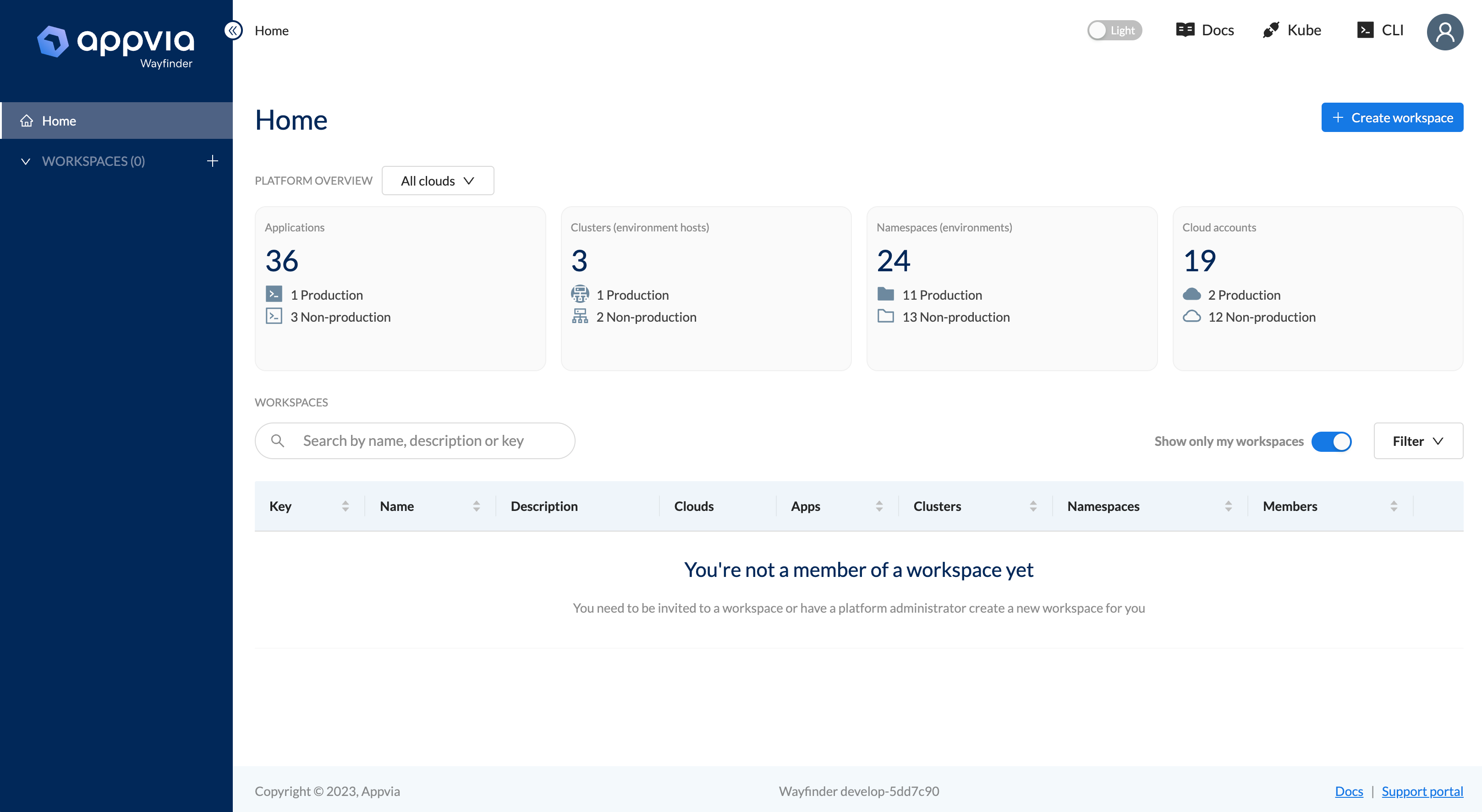
Source: Appvia
Octopus: Deployment automation, environment progression, and self-service runbooks for IDPs
Octopus is a perfect choice for the integration and delivery section of your internal developer platform. It provides best-in-class deployment automation that simplifies the most complex part of your CI/CD pipeline. Additionally, Octopus can orchestrate infrastructure as code tasks and call resource APIs. Octopus Runbooks can be used to provide self-service push-button features for developers with role-based access control and a full audit trail.
We empower Platform Engineering teams to enhance the Developer Experience (DevEx) while upholding governance, risk, and compliance (GRC). Additionally, we are dedicated to supporting the developer community through contributions to open-source projects like Argo within the CNCF and other initiatives to advance software delivery and operations.
Get started with Octopus
Make complex deployments simple
Help us continuously improve
Please let us know if you have any feedback about this page.


